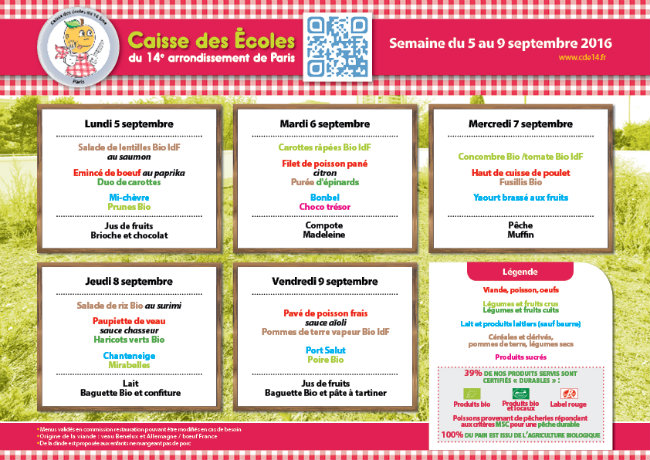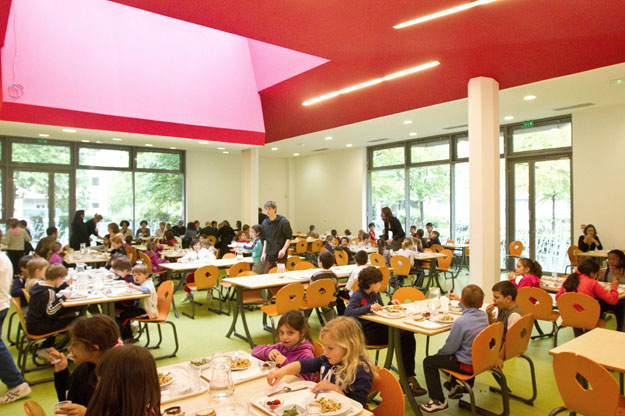The ABCs of French School Lunches

- SUBSCRIBE
- ALREADY SUBSCRIBED?
BECOME A BONJOUR PARIS MEMBER
Gain full access to our collection of over 5,000 articles and bring the City of Light into your life. Just 60 USD per year.
Find out why you should become a member here.
Sign in
Fill in your credentials below.
An appetizer of tomatoes with boiled egg and mayonnaise.
A main course of smoked beef with a gratin of zucchini with new potatoes & béchamel sauce
Organic applesauce and a crêpe with organic compote
Or
Potato salad with diced Emmenthal in vinaigrette
Filet of fresh fish from sustainable sources, tomatoes and olives
Organic fruit in season. A slab of chocolate marble cake.
This sounds like a healthy menu selection from Paris’s Le So, Boco or La Table Verte, but in truth it’s what the elementary school children in the 11th arrondissement are eating for lunch this week.
Other delicious primary school repasts students are dining on throughout Paris this week are items so tempting and healthy they sound like they come from a spa or bio-friendly bistro. In the 5th arrondissement, children are eating salade Arlequin, pork sausage and cream of carrot soup; sole meunière, beets in a mustard vinaigrette or chicken Cordon Bleu– all accompanied by samples of gouda, gruyere and camembert. In and around Belleville they’re having cheese crêpes, lasagna bolognaise and Liègeoise à la vanille – aka pudding – but it sounds so much nicer in French; plus filet of hake in sauce Nantua. In Passy, les élèves are putting away watermelon, grilled turkey cutlets, cauliflower gratin, orange-rinded mimolette and a flan for desert. These budding gourmands are enjoying cheese I’m still not comfortable with.

Weekly menu for schools in the 14th arrondissement of Paris
The French government considers it their duty to provide a daily freshly-prepared meal for over 6 million French children in their public school system. School canteens are required to provide school-age children with: a starter of vegetables, salad or soup; a warm main course high in protein whether it be meat, fish or eggs; a side dish of vegetables or grains; a cheese course or dairy product; plus raw or cooked fruit balanced with a dessert and an afternoon snack.
A national ban on vending machines in all French schools aids in stopping the students from developing a taste for junk food. Typical kids’ food, i.e. chicken nuggets, peanut butter and jam sandwiches or burgers and fries, are unheard of. Students simply eat child-sized portions of adult food. There’s only one daily choice on the menu and until they are finished primary school at age 12, students must eat up or else go home for lunch. “Brown-bagging-it” is discouraged. An added plus: often the ingredients for the meals are organic.
There’s bread on the table and each meal is accompanied with water. Fried food is only served a few times per month, according to Ministry of Education regulations, and ketchup offered only once a week. School lunches must consist of forty percent of the children’s daily nutritional requirements. The nutritional standards regulate how frequently dishes are served in a 20-meal cycle; for example, at least 10 meals in the cycle must be accompanied by cooked vegetables, 10 meals must be accompanied with legumes or grains, and 8 meals out of 20 must have a fresh fruit dessert.
The midday meal is served in a restaurant scolaire, or school restaurant, where food isn’t scooped from huge vats or steam trays. Food is served to children at the table, by helpful lunch ladies who will even assist in cutting the meat of the little ones who are still unable. Vegetables are served first because hungry kids will eat their veggies when presented with them. Here there is no hiding your sprouts under your napkin. Lunch is between noon and two. The French Ministry of National Education sets a minimum time requirement of 30 minutes for children to sit at the table in order to allow them eat their food sufficiently slowly and properly. The remaining time is for play or relaxation.
What about freedom of choice? The French have decided that teaching healthy eating routines to children is a priority. The simple act of lunch incorporates tacit lessons on taste, nutrition, manners and culinary heritage. At a garderie on the rue Mouffetard, nursery-aged children enjoy a Spanish menu every Friday with a bowl of gazpacho followed by fish paella. It’s all about raising children to be at home in the world.
What about equality? French égalité is alive and well in the restaurant scolaire. The school lunch program is not only high quality, it’s democratic and benefits everybody. It’s not just the culinary training ground of the entitled few. The meals themselves cost between 13 centimes and 7 euros, depending on the family’s income. The cost of the meal is subsidized so it is equally available to all children, including those whose parent can not pay. It’s a fine example of socialism at work.

French students at the cantine. Photo: Strasbourg.eu
In 1867 Victor Duray, then Minister of Public Instruction, requested school officials give special attention to the nutrition of children. So began France’s school lunch program. Paris began school canteens in 1877 providing meals at the public expense to children whose parents’ names were on the Poor Board list.[i] Two years later a school lunch program was set up in every arrondissement. Participation was open to all children and their anonymity was fully protected.
As early as 1909, Americans were looking toward the French canteen system for inspiration. Caroline L. Hunt put forth in a bulletin of the United States Bureau of Education that “it seems to be universally conceded that Paris has the best system for feeding the school children that has been worked out by any municipality,” and Paris had much to teach other cities.[ii]
Today each Paris arrondissement sets its own meal guidelines for the schools within its boundaries as long as the national requirements are followed. Menus are readily available for parents online. The mairie of the 7th arrondissement goes as far as suggesting evening recipe ideas, for instance: tartar of tuna and tomato; cake Marin – a quick loaf with shrimps and olives; a clafoutis of zucchini and chèvre.
Good food deserves respect. French school meal programs teach children to be mindful about food from an early age. Later in life these children can make informed and mature choices about nutrition because of their early exposure to diverse tastes and healthy choices. Food education is really up to every parent too; mindfulness about food at school or at home is beneficial to everyone.

The Cantine Scolaire. Photo: The city of Paris
[i] Gordon W. Gunderson. The National School Lunch Program: Background and Development. (New York: Nova, 2003).
[ii] Caroline L. Hunt. The Daily Meals of School Children. United States Bulletin of Education. Bulletin 1909. No 3. (Washington: Government Printing Office, 1909).
Lead photo credit : Paris school lunch. Photo: Caisse des ecoles du 6eme



REPLY